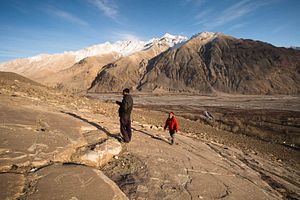A month has passed since 18 ethnic Kyrgyz packed their belongings into vans and started the long journey from Naryn oblast in east-central Kyrgyzstan back to the Pamir mountains of the Wakhan corridor, a sliver of territory in northeastern Afghanistan where several thousand Kyrgyz have lived for a century.
These two families returned to Afghanistan after less than a year in Kyrgyzstan. On October 13, 2017, they had arrived in Naryn City as part of a bigger group of six families. A crowd of several hundred people welcomed the 33 newcomers with music and candy as they climbed down from the sturdy vans that had carried them all the way from Afghanistan.
The mood was festive, despite the Pamiris’ stern, smileless faces as they sat in a long row for photographs and interviews with local media. “We are so happy to get to come and study,” teenaged Turgunbai Abdilebi uulu told Azattyk reporters. “I’m going to study really hard.”
The Afghan Kyrgyz community’s arrival in October was decades in the making. Twentieth-century geopolitics had boxed in several thousand Kyrgyz nomads who found themselves in Afghanistan when the borders of China, Pakistan, and Tajikistan hardened. Since Kyrgyzstan gained independence in 1991, successive leaders have called for helping their Pamiri boordosh, or ethnic kin, whose numbers have dwindled as a result of harsh living conditions and extreme isolation.
This ethno-centric rhetoric of uniting the Kyrgyz diaspora came to a head with the Kairylman (Returnee) program, established in 2006 by then-Prime Minister Feliks Kulov. Through the Kairylman program, ethnically Kyrgyz foreigners without Kyrgyzstani citizenship were given bureaucratic and material support – in the form of education, medical treatment, and land allocation – to return to their “homeland.” Of the 636,000 ethnic Kyrgyz living in other countries, around 50,000 had taken advantage of this opportunity by 2016.
Meanwhile, the repatriation question loomed large for the Afghan Kyrgyz community; political upheaval and economic challenges meant that no moves were made to bring the Afghan Kyrgyz community to Kyrgyzstan in the decade after the program began.
That changed with the arrival of six Afghan Kyrgyz families in October 2017. The first months were a difficult but exciting adjustment period, as the group settled in to dormitories in Kulanak village, about 30 kilometers west of Naryn City, for medical observation and initial schooling.
Local government officials coordinated with state agencies to make life comfortable for the Afghan Kyrgyz. Head of the State Migration Service’s Department for Working with Kairylmans Jypara Mambetova promised that everything would be provided for. “How can we leave them without support? We’ll do everything in order for them to get accustomed to independent life,” Kloop reported her saying on November 11.
It didn’t take long before mismatched expectations about the extent of that support brewed frustration. While school-aged children attended lessons from teachers who traveled from nearby villages to teach the Pamiris how to read and write in Cyrillic, the parents and older family members who had accompanied them grew bored. Without work or school, 43-year old Saidirakhman Appai uulu summed up daily life: “We just sit.”
Kyrgyzstan is not the only Central Asian country to struggle with managing the titular ethnic group’s diaspora. Ethnic Kazakh returnees, lured by the promise of steady work and a plot of land, have also expressed frustration with what they feel has been a less-than-welcoming attitude of the government and their new neighbors.
The popularity of these returnee programs demonstrates just how powerful the myth of a homeland can be. In Kyrgyzstan’s case, however, it took only a few months for that myth to crumble under the weight of the bureaucratic and logistical demands of mass population transfer.
When it became clear that families would not be given land, as they had expected, several decided to leave. Abdylgafar Abdyrasul uulu, one of the Pamiri Kyrgyz who returned to Afghanistan in July, cited the lack of money and a permanent home as his reasons for leaving Naryn. “There’s no work, and I can’t pay rent. … Before, they said they would give us land, but now they won’t listen to us. It’s better to leave than stay here and suffer,” Abdyrasul uulu said.
On July 2, as two of the six Afghan Kyrgyz families began preparing for the week-long journey back to the Pamirs, government officials tried to get ahead of any criticism. Mambetova, of the State Migration Service, revised her previous promise to provide “everything,” clarifying, “As for the land, we should remind them that they came here exclusively for education… Our government created the appropriate conditions. I don’t understand why anyone is saying, ‘If they don’t allocate land, then we’ll leave.’”
The progression of the government’s attitude toward the Pamiri Kyrgyz – from eager hospitality to reluctant distance – reveals a tension between ideology and logistics, between ethno-nationalist support for the titular diaspora and the realities of bureaucracy and limited state capacity.

































